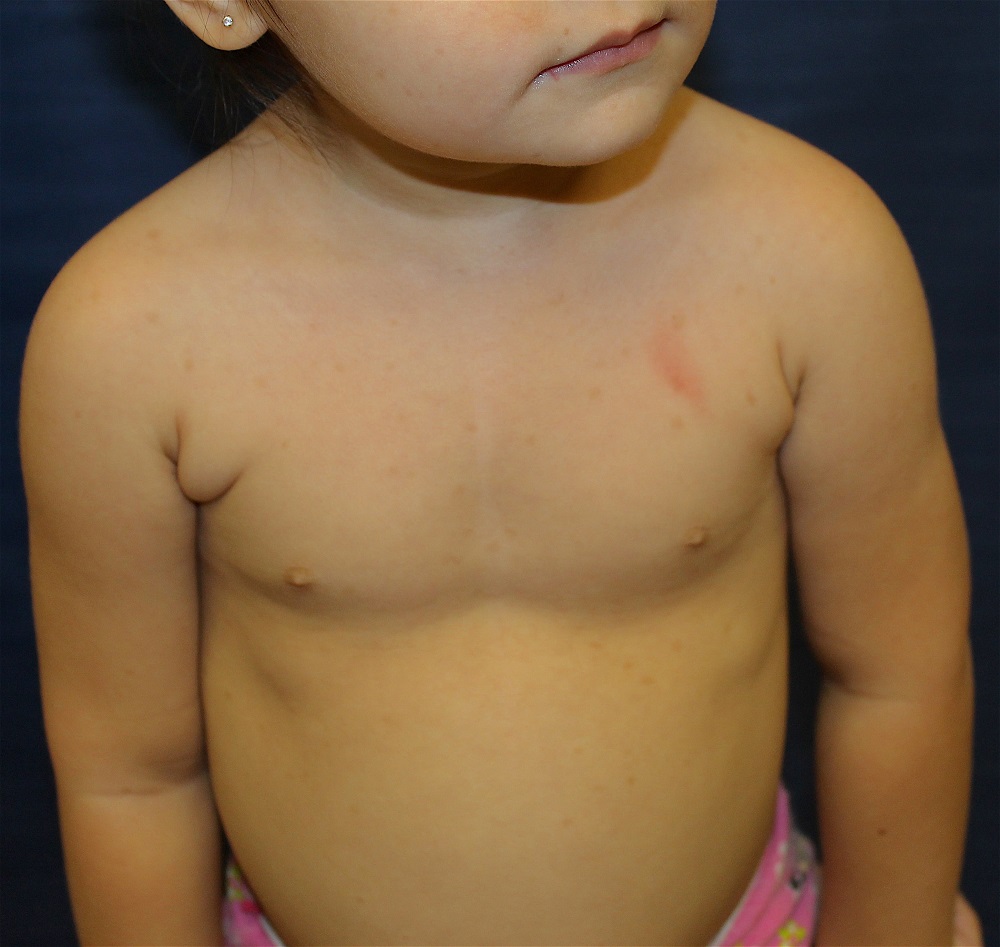Urticaria pigmentosa
BY CATALINA MATIZ, MD, AND JEREMY UDKOFF
Frontline Medical News
Maculopapular cutaneous mastocytosis (MPCM), colloquially known as urticaria pigmentosa, typically presents as multiple brown lesions on the skin and accounts for the majority of pediatric cutaneous mastocytosis.1 The category of cutaneous mastocytosis also includes diffuse cutaneous mastocytosis (characterized by generalized erythema and thickened skin), solitary mastocytoma (present as a solitary brown or red lesion), and telangiectasia macularis eruptiva perstans (diffuse telangiectatic macules on the skin, usually in adult patients).
Cutaneous manifestations of mastocytosis are caused by collections of mast cells and the local release of their mediators into the skin. Some of these patients can present with pruritus and flushing, and rarely with diarrhea, abdominal pain, or heart palpitations. Alternatively, systemic mastocytosis, where mast cells invade extracutaneous organs such as the bone marrow or the gastrointestinal tract, may present with or without associated skin lesions. These patients usually have more severe systemic symptoms such as fever, weight loss, epigastric pain, neuropsychiatric symptoms, or bone pain.2,3

One of the lesions reddened and wheeled after we stroked it.
The pathogenesis of mastocytosis revolves around abnormal mast cell proliferation. These mast cells then accumulate in organs such as the skin. Mechanical stimulations result in a release of cell mediators, such as histamine, eicosanoids, and cytokines, that causes the associated symptoms. Recent studies have shown c-KIT mutations to be present in the majority of mastocytosis cases, and these mutations are thought to contribute to disease progression.6
Differential diagnosis
Because of its varied presentation, the differential diagnosis for MPCM includes café au lait macules, lentigines, nevi, lichen planus, pseudolymphoma, diffuse juvenile xanthogranuloma, and Langerhans cell histiocytosis. Although these diseases may include macules and papules that look similar to MPCM, the Darier’s sign is an extremely powerful tool in differentiating these diseases as it is almost always present in mastocytosis. When there is a history of blistering lesions, the differential diagnosis should include epidermolysis bullosa, herpes simplex, bullous arthropod bites, bullous impetigo, linear IgA dermatosis, and rarely autoimmune bullous conditions. Equivocal cases should be referred to a pediatric dermatologist for evaluation, as conditions such as Langerhans cell histiocytosis and epidermolysis bullosa are usually associated with poor outcomes.
Work-up and treatment
In cases where the lesions are not classic or there is not a clear Darier’s sign, a skin biopsy with special staining, such as Giemsa or toluidine blue, is recommended to help clarify the diagnosis and rule out other worrisome conditions as mentioned above. If the child presents with systemic symptoms, performing a complete blood count with differential, tryptase level, and organ-specific testing based on the symptoms is recommended.
Serum tryptase is a biomarker for mast cell degranulation. It is typically normal in pediatric patients with MPCM but may be positive if there are symptoms of systemic disease such as fever, weight loss, bone pain, epigastric pain, headaches, or anaphylaxis. Similarly, the risk of anaphylactic reactions correlates with the serum tryptase level.4,7 If the tryptase level is elevated, a bone marrow biopsy should be performed to rule out more severe forms of systemic disease.
Potent topical corticosteroids, such as fluocinonide, are typically used to the treat cutaneous lesions when they are inflamed. Other supportive treatments used in MPCM usually revolve around controlling the cutaneous symptoms as there is no cure for the disease. H1 and H2 antihistamines may be used alone or together to control itching and are thought to decrease flushing and blistering associated with MPCM. Other possible treatments include topical cromolyn sodium and leukotriene antagonists. Mastocytoma lesions that are increasing in size or are very symptomatic despite the treatments listed above may benefit from local immunosuppressants, ultraviolet radiation and psoralen application, or excision.8
Lifestyle modifications also are recommended for patients with mastocytosis. They are advised to avoid foods, medications, and environmental triggers that can cause mast cell degranulation. These triggers include aspirin, nonsteroidal anti-inflammatory agents and narcotics, topical polymyxin B sulfate, heat, friction, and certain systemic anesthetic agents.9
References
1. Br J Dermatol. 2015;172(3):642-51.
2. Clin Pediatr. (Phila) 2008;47(8):757-61.
3. “Mastocytosis,” in Dermatology, 3rd ed. (China: Elsevier, 2012).
4. J Allergy Clin Immunol. 2016;137(1):35-45.
5. J Allergy Clin Immunol. 2015 Dec;136(6):1581-90.e1-e3.
6. J Invest Dermatol. 2010;130(3):804-15.
7. Pediatr Dermatol. 2014;31(3):271-5.
8. Eur J Clin Invest. 2007;37(6):435-53.
9. “Histiocytosis and Malignant Skin Diseases,” in Hurwitz Clinical Pediatric Dermatology: A Textbook of Skin Disorders of Childhood and Adolescence, 5th ed. (China: Elsevier, 2016).
Dr. Matiz is assistant professor of dermatology at Rady Children’s Hospital San Diego–University of California, San Diego, and Jeremy Udkoff is a medical student at the university.


